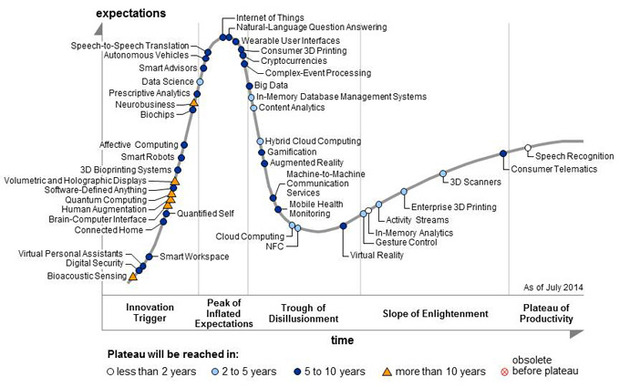
Hype can be a divisive word. In terms of emerging technology, hype can be spun as positive buzz, inflated expectations, in-demand and trendy, or markedly oversaturated. But what it doesn’t translate to is real-world value.
Research firm Gartner defines its yearly Hype Cycle report as a “model designed to help clients make intelligent decisions about when to implement emerging technologies,” but its jargon-laden “phases” make it seem as if each new technology must undertake a biblical journey. That’s not to say the report doesn’t offer valid insight into when enterprises should adopt an emerging technology, but somewhere between the “Trough of Disillusionment,” the “Slope of Enlightenment” and the “Plateau of Productivity,” the true market-applicable value of a trend like the Internet of Things can get lost.
(Report: Internet of Things hype is peaking)
In the 2014 Hype Cycle report, the Internet of Things overtook Big Data atop the “Peak of Inflated Expectations.” Right behind IoT on the curve are wearable UIs and natural-language question-answering, popularized by intelligent personal assistants like Siri, Google Now and Cortana. But in the long term, what this actually means for these emerging technologies is—as the key at the bottom of Gartner’s chart reveals—that mainstream adoption is five to 10 years away.
As hyped as the Internet of Things is perceived at this moment, when all the cockamamie smart objects we like to refer to as the Internet of the Stupid fade away, an interconnected network of embedded computing devices is a marketable idea. The same goes for wearables. The market is flooded with more wearables for your head, hands and body than even our April issue’s wearable Vitruvian Man could handle, but as the technology advances past a fad, and the cream of the wearable crop becomes part of daily life, we’ll need more and more programmers to code user interfaces for them. Natural-language question-answering is evolving and permeating throughout a wide array of industries as well, as AI systems such as IBM’s Watson find their way into the hands of developers.
(Download the free April 2014 issue PDF to read our cover story on the wearables boom!)
Hype clouds objective judgment of innovation, leaving marketability mired in buzzwords. Not every emerging technology on Gartner’s chart will find mainstream success of course, but as with any product, the individual applicability of each Internet-connected thing or smart device will determine its staying power and ultimately its market value—not how much hyperbole is spewed about it.
As for the hype, it’ll always be there—ebbing and flowing—and Gartner’s annual report will ensure we all pick up this discussion again, same time next year.





